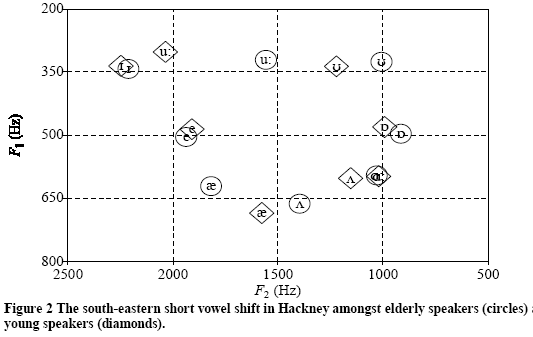DEPARTMENT OF SPEECH, HEARING & PHONETIC SCIENCES UCL Division of Psychology & Language Sciences |
 |
|
John Wells’s phonetic blog archive 16-31 March 2008To see the IPA phonetic symbols in the text, please ensure that you have installed a Unicode font that includes them all, for example Lucida Sans Unicode or Charis SIL (click name for free download). Browsers: I recommend Firefox (free) or, if you prefer, Opera (also free). email: |
Monday 31 March 2008 | Ortuguese?There is one column in the Guardian newspaper that is an unfailing source of delight: ‘Corrections and clarifications’. Last Friday it kicked off with an apology. We wrongly reported that a proposed reform of the Portuguese language could mean that the letters c, p and h are removed from the alphabet. After the original report appeared Enda O'Doherty, a Dublin reader, wrote in to say I fear on my next visit the atmospheric second city of Oorto, the ancient university centre of Oimbra and many other places I have loved in Ortugal will be, well, just not quite the same. The Guardian’s correction continued, The Orthographic Accord signed by Portuguese-speaking countries seeks only to remove these letters from words where they are never pronounced, such as húmido (humid). The letters will remain in the alphabet for words where they are pronounced (World’s Portuguese speakers in new attempt to unify language, page 16, March 26). In the same article we said one of the signatories to the accord is Western Timor when we meant Timor-Leste (formerly East Timor). A proper account of the Acordo Ortográfico can be found in Wikipedia. If the Guardian journalist were a student of mine I would also have pointed out to him that a minor change in spelling conventions is not a “reform of the Portuguese language”. A language remains the same no matter how it is represented by marks on paper. German remains German, no matter whether you write daß or dass. English would still be English if we were to reform its chaotic (cayottic) spelling. Portuguese remains Portuguese with the spelling úmido just as much as with the spelling húmido. On the other hand getting rid of gender, for instance, or regularizing irregular verbs like fazer — that would be language reform. |
|
Friday 28 March 2008 | Panglish, or unintelligibility?Oh, Jennifer Jenkins, what have you started? Steve Akamatsu drew my attention to a sensational article in yesterday’s Daily Mail.
... to be replaced by 'Panglish' |
|
Thursday 27 March 2008 | Friern BarnetIn north London, in the London Borough of Barnet, is a place called Friern Barnet. The earliest recorded form of this name is Frerenbarnet (1274). The first part of the name, Freren, is the Middle English (from French, from Latin) for ‘of the brothers’, and refers to its early possession by the Knights of St John of Jerusalem. Not too far away there is another place, Monken Hadley. It is so called after the monks of the monastery which was once there. As Monken is to monk, so Friern is to friar. In Friern Barnet there is a Friary Park. Obviously, therefore, you would expect Friern to be pronounced ˈfraɪən, just like friar. And that is indeed how many people say it. Others, though, call it frɪən. Presumably this variant arose as a spelling pronunciation, on the analogy of words like pier pɪə, fierce fɪəs and so on. (But compare fiery with aɪə.) Both forms are given in Graham Pointon’s BBC Pronouncing Dictionary (OUP 1990). Both are duly recorded in EPD and LPD. But ODP has only ˈfraɪən, which I think is OK prescriptively but not descriptively. |
|
Wednesday 25 March 2008 | Changing London speechDaniel Moog wrote to say that according to an article he had read an occurrence currently happening in London is the development of a “multi-ethnic dialect” seeming independent of social origin and including patterns “from Cockney, Jamaican creole, Bengali and other languages”. ...Is it rather fact than fiction or is it more like a hype such as about Estuary English? What is your opinion? My reply was that this research is highly respectable, being the work of well-known sociolinguists. To quote this report, The teenagers also used words like blud (blood, meaning mate), creps (trainers), yard (house), and endz (area or estate). Prof Kerswill believes this new form of speech, which they refer to as Multicultural London English (MLE), arose as more recent immigrants learned English with few English-speaking role models. “I think there has been a change in the last 30 years. The first generation of Afro-Caribbean children in London would have spoken Cockney, but they would have kept their own Caribbean patois and switched between the two. Now their descendants - and young people of other ethnicities - are inventing a new form of English.” The phonetic part is reported more technically in an article written by Jenny Cheshire, Sue Fox, Paul Kerswill & Eivind Torgersen, from which the following chart is taken. What particularly interests me is the change in vowel qualities among young inner-city speakers.
You can see in this formant plot the striking anticlockwise movement of TRAP, STRUT, FOOT and GOOSE (/æ, ʌ, ʊ, uː/). This makes cat, for example, into [kat], so pretty similar to older Cockney cut, and leaves cut as [kɑt], with a very similar quality to that of cart [kɑːt]. Meanwhile FOOT and GOOSE lose their rounding and are no longer back but central or even front: /ʊ/ becomes more schwa-like and /uː/ turns into a sort of [ɨː] that can sound alarmingly similar to RP /iː/. As the authors say, this confirms what they had already observed in other southeastern localities. (See also this blog for 4 October 2007.) In London, however, they find that the changes in STRUT and GOOSE are led by young non-Anglos (of African, West Indian etc. heritage) and Anglos (white English) with non-Anglo friends rather than by Anglos who socialize mainly with other Anglos. It makes the new London STRUT similar to Jamaican STRUT but makes GOOSE very different from Jamaican GOOSE, which is firmly back and rounded. The authors go on to describe the “reversal” of the London diphthong shift, leading to the restoration of RP-like qualities for FACE, GOAT, PRICE and MOUTH. Furthermore, they report, the young speakers drop h very much less than the older people; and they have an innovation called K-backing, involving [q] or something similar before non-high back vowels, as in cousin, car, cot, caught. There is a Powerpoint presentation about it here. |
|
Tuesday 25 March 2008 | Fricative trill, trill fricativeIt’s one of the rarest sounds in the world’s languages. There may well be no language other than Czech that has it. I’m referring, of course, to the fricative trill, orthographically ř, which we all know through the name of the composer Dvořák (Wikipedia sound file).
Here you see a scan of the IPA Council’s 1945 decision to adopt the symbol ɼ to represent this sound, a voiced alveolar fricative trill. (The handwritten amendment to the voting figures is Jones’s own.) The composer’s name could then be transcribed ˈdvoɼaːk. One of the decisions made at the IPA’s Kiel Convention in 1989 was to withdraw recognition from this symbol. The IPA members voting at the Convention took the view that it was adequate to use the ordinary symbol r (voiced alveolar trill) together with the ‘raised’ diacritic to show the closer, hence fricative, articulation. So in the Handbook of the IPA (CUP 1999) you will find the Czech consonant written as r̝. (One of the bugs with the Lucida Sans Unicode font is that it does not display this diacritic satisfactorily. I am using a different font, subject to the limitations of your computer and browser, to display it.) Dvořák is now ˈdvor̝aːk. (If you find that IE garbles this, try Firefox or Opera.) Brian Jenner writes to say he regrets this decision, and I am half inclined to agree with him, though it does seem an unnecessary luxury to have a special symbol needed only for one language. (But compare Swedish ɧ.) The fricative trill also occurs voiceless, though only as a positional allophone after voiceless consonants (tři ‘three’) and word-finally (pekař ‘baker’). Both with the old symbol and with the new one there is a problem about transcribing this variant (if you feel you need to). There’s no room for a voiceless diacritic underneath, so it has to go on top: r̝̊. Bill Lee’s Teach Yourself Czech (EUP 1964) offers excellent pronunciation advice to the learner. Here is the description by my colleague Jana Dankovičová in the Handbook of the IPA, page 71. |
ɼ r̝
|
|
| ||
You might be interested in this, from the Sunday Times, 23 March: Correct Pronunciation on the Radio.
Monday 24 March 2008
Following on from Friday’s discussion of the mutual incomprehension between voice teachers and phoneticians, I received an email from Philip Thompson, President of the Voice and Speech Trainers Association.
Eric Armstrong, who likewise has something of a foot in both camps, makes these comments.
Friday 21 March 2008
There has recently been an exchange of views in two email groups to which I belong, which I wanted to share with a wider audience.
It started with a request on the Vastavox list.
A reply came from Sue Ann Park of the Lessac Institute for Training and Research.
It has long worried me that phoneticians and those in the allied field of voice training don’t seem to be talking the same language. I wrote as follows.
Karen Chung has just reviewed Lessac’s book The Use and Training of the Human Voice. She explained to me privately that
Mark Jones of the Dept. of Linguistics at the University of Cambridge offered some advice.
I fear, though, that phoneticians’ talk of low F3 (that is, third formant) and aryepiglottal articulation may be as meaningless to the voice people as their talk of the vibratory presence of something (the back of the tongue? the r-sound?) near the back of the hard palate is to phoneticians.
But we need to be able to talk to one another. To quote the musical Oklahoma!, territory folk should stick together: the farmer and the cowman should be friends.
Thursday 20 March 2008
Here’s one more posting relating to prosodic differences between English and German. It concerns stress in compounds. Although the two languages share the general principle of putting primary lexical stress on the first element of a compound, English has a rather large number of exceptions where German does not. These include cases where the first element names a material, ingredient, time or place. English usually stresses the second element, German the first.
(A 'leatherjacket, on the other hand, is a kind of grub.)
Assorted other cases:
There are exceptions in English where the first element names an ingredient (etc.) but we nevertheless have regular compound stress on the first element.
And there are certain place names where German nevertheless has stress on the second element.
Just as English is hopelessly inconsistent in 'Christmas cake/card/tree/present but Christmas 'Day/'Eve/'pudding/'crackers, so German is inconsistent in 'Heiligenberg/-haus/-stadt/-wald but Heiligen'beil/-'blut/-'damm/-'hafen/-'kreuz. (German data from the Duden Aussprachewörterbuch.)
My impression is that the other Germanic languages (Dutch, Danish, Swedish, Norwegian, Icelandic, Faroese) mostly have fairly regular compound stress. In Norwegian and Swedish it involves a special word tone, in Danish their stød (glottalization).
If this is not the case, I am sure someone will let me know. Wednesday 19 March 2008
One difficulty about doing comparative intonation studies is that we are interested (or at least I am) not so much in the surface differences in tune shape, but in the deeper differences, if any. Do the two languages differ in such matters as That is, are there differences in the three Ts: tone, tonality and tonicity? And to discover whether such deeper differences exist you need to have access to native speakers who have insight into what is going on. You won’t get very far by just sitting in a phonetics lab analysing the pitch patterns of random utterances.
I think it’s clear that English and German have a good deal in common, not just in vocabulary, syntax and morphology, but also in intonation, if seen in this light. The same is probably true for all the Germanic languages.
There are differences, of course. We discussed one yesterday. Another concerns sentences consisting of a major part with a minor part, for instance some adverbial or other subordinate material. English has two favourite intonation patterns for these. If the minor part comes first, it tends to have a fall-rise, followed by a fall on the major part. If the major part comes first, it has a fall, usually followed by a rise on the minor part. Thus, depending on the order we choose for the two parts, we might have either of the following.
In German there is a strong preference for a rise on the minor part and then a fall on the major part. (The other option, with the adverbial at the end, so-called Ausklammerung, is apparently now becoming commoner than it once was but is still very restricted.) There are two straightforward possibilities for the word order.
It would be awkward or impossible to say, as in the second English pattern,
Though of course it would be OK with a change of speaker and with heute Abend as a question.
(Thanks to Petr Rösel — again — and Christopher Bergmann.)
Tuesday 18 March 2008
I continue to fret about anomalous tonicity. Consider the accenting of the word to in exchanges like this, heard recently.
Logically, you would think, B’s intonation nucleus ought to go on nothing. But it doesn’t. It goes on the function word to. Why?
(We ought not to call this to a preposition. In its role as part of an English infinitive, as here, Huddleston and Pullum call it a VP subordinator.)
Other ways for B to say the same thing in his answer include these.
Or the idea can be lexicalized.
Or, going back to the first version, we can change nothing to not anything.
This is another of those counterpresuppositionals (blog, 22 Feb 2007), and one explanation that has been offered is that the accented to signals marked polarity. The speaker emphasizes the absence of anything that is doable, as against what is not. So we have a marked positive.
However, there is a difficulty here. Taking the sentence as a whole, the speaker is saying that nothing is possible. The polarity is negative, so it seems perverse to talk of a marked positive.
A marked positive would be expected to be the dubiously acceptable
Compare what happens if B gives an answer with negative polarity for do. The nuclear accent goes on the negator.
Notice that it is impossible with negated do to accent to.
I feel confused.
I gather that in German things are somewhat more straightforward. You don’t accent zu where you would English to.
Instead, you accent the word corresponding to English is. (Thanks, Petr Rösel.)
or
Apparently, though, while you cannot have accented zu to show marked polarity, you can have it to show marked tense. So the following might be OK. How difficult it all is! P.S. Petr Rösel asks what happens with a slightly different wording.
I think I could then accent be or to.
Monday 17 March 2008
My bedside radio comes on at 06:30. It is set to BBC R4. So in the early morning every Saturday I get a dose of Farming Today.
This past Saturday had a discussion about vets (in the BrE sense ‘animal doctors’, of course, not the AmE ‘exservicemen’) and the problems that arise from the fact that working with companion animals (cats, dogs, rabbits) is nowadays much more lucrative than working with farm animals. This causes a shortage of vets prepared to work down on the farm.
Naturally, the word veterinary was used repeatedly. I was struck by the fact that the only pronunciation I heard, whether from farmers, from vets themselves, or from their teachers at university, was ˈvetn̩ri or the phonologically equivalent ˈveʔn̩ri, ˈvetənri. Only three syllables, only one r.
Back in the Jones-Gimson-Ramsaran days this pronunciation was given in EPD as a variant. But the current editors, Peter Roach and Jane Setter, have removed it, leaving only spelling-based forms such as ˈvetərɪnəri, with more consonants and more syllables.
Same in ODP.
In LPD I do give both types, though with priority to forms that have r near the beginning as well as near the end. You have to infer ˈvetn̩ri by unpacking the rather complex ˈvet ən ər‿|i. (Perform this operation by ignoring the raised and italic letters and the cutback line, and compressing the last two syllables into one.)
Perhaps we’re all going to have to yank our entries for this word into line with actual usage — at least as exemplified in Farming Today.
To search my web pages, use this Google search.
Phoneticians and voice teachers
I entirely agree with your insistence on
accurate (verifiable) descriptions of the physical actions and anatomy of
speech. Theatre Speech teachers, working in isolation from phoneticians and
other linguists, aren't subject to the salutary buffeting of scientific
skepticism. Our teaching will only be made stronger by the demand for
clarity.
I should protest, though, that some of us are perfectly
comfortable talking about third formant lowering (or raising in the case of
the uvular fricative /r/). I usually don't use these terms with acting
students. Actors are unwilling to take on too much information as the
price of learning a necessary skill. They want to do something. And Voice
and Speech teachers are often very skilled at guiding students to the
physical experience that allows them to grasp an articulatory skill. The
language we use along the way is often fanciful, resorting to imagery more
than spectrography. One on one with an actor, that language is probably more
effective.
Where we get in trouble, though, is when we mistake image for fact. I am
very careful when working with student-actors, to explain the difference,
and to acknowledge when I am passing from one mode to another. With that
precaution in place, I'm perfectly comfortable with beams of energy, chakras
and the like. Whatever works.
Most voice trainers, and I'd argue most voice students, will interpret the
intent behind the discussion of "vibration" in Sue Ann's post, and language
like it heard in voice studios across the Western world, as referring not to
the kind of vibration that Wells is referring to, but to a sensation of
sympathetic vibration in the tissues of the oral tract. Rather than relying
exclusively on proprioceptive awareness of the articulators place in space,
many trainers use those sensations of vibrations, often, even more
confusingly, labeled "resonance," to describe the outcome of the the
different positions of the articulators and the sound and its qualities. As
the articulators move, the sensation moves too, and many actors appreciate
the "vibration" more acutely than the movement.
Some training methods rely heavily on the "awareness of vibration" approach,
probably most notably the Lessac approach to voice and the Stern approach to
accent training, though they have no exclusive hold on it, as almost all
methodologies touch on it to some degree. Trainers who brand their approach
to voice frequently describe their methodology in pseudo-scientific
terminology, or jargon that makes an approach exclusive, special and
marketable. Usually it is the language that worked well for them in the
classroom.
I believe that the approach that Sue Ann describes can work — she is an
accomplished teacher with more years teaching actors than I can ever aspire
to. Do I do it that way? No. But I like to believe that I can learn from her
approach, and try to glean what works, and perhaps even guess at why it
works. When she says "out of the throat and into the hard palate," I know
what she means! It is not fantasy for me. She is referring to a state where
she feels a sensation of vibration more strongly on the tissues and bones
of the hard palate than in the pharynx. Unfortunately this is a very vague
way of describing an articulation, as there are many sounds that can be made
with a greater sensation of vibration.
Voice trainers aren't scientists, generally, so our point of view is
different. We work with scientists, such as phoneticians, to become more
adept at teaching ourselves and then our students about how the voice works,
and then we work to adapt that knowledge into useful tools for acting. That
isn't always an easy task. It's not hard because of the actors, it's because
we're not explaining clearly enough for them, in a way that they can
appreciate and not be isolated from because it appears either too technical
or too "airy-fairy" or vague. Finding that balance is a huge challenge, and
it must be something we continue to work towards, including always
questioning how we choose to present our approach to voice.

Philip Thompson

Eric Armstrong
Voice teachers and phoneticians
Any of you have any particular sure-fire (or almost?) exercises for a French speaker who is learning the English R? I'm not quite happy with a client's progress with my tongue, soft palate, placement-comparison exercises.
Is what you have worked with to help a French speaker make an American R any different from this, which we use to teach those Americans who make the R with the R-colored vowel?
While humming on an NG, with the back of the tongue gently hugging the back of the hard palate, feel sides of the tongue hugging the side teeth. Then, curl the front of the tongue up like a spoon and then, gently release the back of the tongue from the hard palate without stopping the voice and develop this R by improvising personal melodies or using melodies one knows to get the identifying sensation of its vibratory presence near the back of the hard palate.
When the R occurs before a vowel, its vibration will last just long enough to be felt, then, the front of the tongue rests down behind the lower teeth for the vowel.
Note 1: A forward facial posture like that of an AW (Lessac #3) focuses the vibration out of the throat and into the hard palate.
NOTE #2: In many regional American dialects this R (rhotic?) vibrates harshly and tensely in the throat which is unhealthful for the throat and is a distracting noise that many listeners object to.
(The R is the Trombone in the Lessac Consonant Orchestra)
Forgive my saying so, but Sue Ann Park's posting is an example of what makes meaningful discussion between phoneticians and voice people so difficult.
From the phonetic point of view (i.e. objectively describing the activities and configurations of the organs of speech), American r involves no kind of "vibration" (except that of the vocal folds, which is found in all voiced sounds). Talk of vibration "out of the throat and into the hard palate" or of something (other than the vocal folds) vibrating "harshly and tensely in the throat" is fantasy, or is irrelevant to the articulation of r, or maybe involves the use of the term "vibration" in a sense different from its phonetic meaning (= rapid intermittent closure).
Italian, Spanish, and Russian r, on the other hand, DO involve vibration, namely that of the tongue tip against the alveolar ridge. This is why r-sounds in those languages are often called vibrants.
In its manner of articulation, ordinary American English r is not a vibrant (= trill, tap or flap) but an approximant (= frictionless continuant). Its place of articulation ranges from postalveolar to retroflex, often involving a bunching of the tongue body towards the molars.
French r is typically a uvular fricative.
These asssertions can be demonstrated (or for that matter could be disproved, if wrong) in the phonetics laboratory, using techniques such as sound spectrography, electropalatography, cineradiography and now fMRI scanning.
Which is not to deny that as teaching techniques Sue Ann Park's approach may work excellently, as discussed by Kenneth Pike sixty-odd years ago. It's just that the assertions are not actually true.

Sue Ann Park
Sue Ann, quoting Lessac, is talking about formant resonance here (not vocal fold vibration or trills). Regarding "throat", Lessac correctly observes that making an American
"r" too strong pulls the whole articulation, including surrounding
vowels, down into the throat, because "r-bunching" involves considerable
pharyngeal tension.
There are obvious question about the usefulness of using terms like "vibration" for an oral articulation to a speaker who probably has a better proprioceptive idea of what some kind of oral vibration feels like than most American English speakers. Using a comparison like that in [Sue Ann’s] Note #2, which seems to be describing a uvular trill or something aryepiglottal (though the comment on "unhealthful" mystifies me) might confuse the pupil, even if it's not part of the actual training strategy.
Very often these production problems are associated with perception problems (as the well-documented case of /r/ and /l/ and Japanese learners of English demonstrates, though not always completely straightforwardly). It might help to work out what your French speaker is hearing. Maybe s/he is hearing the lingual approximant low F3 /r/ as more like [v] or [w]. Evaluating the phonetic variant s/he is using may provide a key to this too, of course. A bit of ear-training first to make sure that low F3 /r/ is properly heard and contrasted might work wonders. If s/he can hear low F3 /r/ as distinct from other contrasts, imitation might be enough on its own. American English kids seem to learn adult-like productions of syllabic /r/ (i.e. in watER) before consonantal ones, so you could also start there, though rhoticised vowels are probably even harder for non-natives.

Karen Chung
Mark Jones
Compound stress in English and German
ham 'sandwich 'Schinkenbrötchen
evening 'paper 'Abendblatt
summer 'holidays 'Sommerferien
kitchen 'table 'Küchentisch
leather 'jacket 'Lederjacke
town 'hall 'Rathaus
Leicester 'Square Ale'xanderplatz
capital 'city 'Hauptstadt
'fruit cake
'soda water
'orange juice
'breadcrumbsKurfürsten'damm
Friedrichs'hagen
Heiligen'hafen

a leather 'jacket, eine 'Lederjacke

a 'leatherjacket
More comparative English and German intonation
This \/evening | I’m re'turning to \London.
I’m re'turning to \London | this /evening.
Ich 'komme heute /Abend | nach \London zurück.
Heute /Abend | 'komme ich nach \London zurück.
?* Ich 'komme nach \London zurück | heute /Abend.
A. Ich 'komme nach \London zurück.
B: Heute /Abend?

returning to London
nach London zurück
Accent on a VP subordinator
A: 'What are you going to 'do?
B: There’s 'nothing 'to do. B: There’s 'nothing I 'can do.
B: There’s 'nothing I 'could do.
B: There’s 'nothing 'left.
B: There’s 'nothing 'possible.
B: There 'isn’t anything 'to do.
B: ?There 'is nothing to do.
B: There’s 'one thing 'not to do. (And 'that’s re'sign.)
B: There’s 'one thing I will 'not do.
B: There’s 'one thing I 'can’t do.
B: *There’s 'one thing not 'to do.
B: *There’s 'one thing 'to not do.
B: *Da 'gibt’s nichts 'zu tun.
A: 'Was wirst du 'tun?
B: Es 'gibt (aber) nichts zu tun.
B: Da 'gibt’s nichts zu tun.
B: Es 'gibt nichts 'zu tun, | es hätte schon 'längst ge'tan werden müssen.
‘There’s nothing to do (now), it ought to have been done long ago’.
A: What are you going to do?
B: There’s nothing to be done.B: There’s 'nothing to 'be done.
B: There’s 'nothing 'to be done.

Veterinary


Archived:










 Eivind Torgersen and Paul Kerswill
Eivind Torgersen and Paul Kerswill




